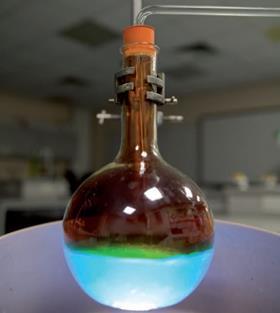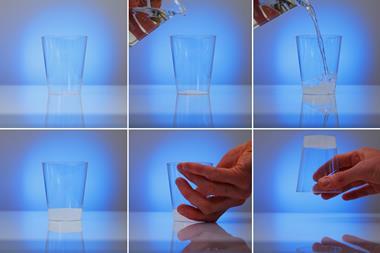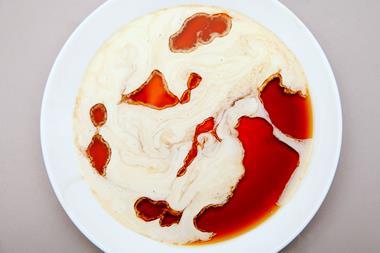The dramatic reaction between copper and nitric acid ought to be seen by all post-16 students. It provides an excellent opportunity to explain observations using the electrochemical series and makes the point that there's more to consider about an acid than its dissociated protons. As well as showing how dramatically copper reacts with nitric acid, this adapted demonstration also uses the high solubility of nitrogen dioxide to initiate a pleasing fountain.

Kit
- 5 g copper turnings
- 40 cm3 concentrated nitric acid
- 1 dm3 round-bottomed borosilicate flask. Preferably thick-walled.
- clamp stand
- delivery tube
- 1 dm3 conical flask
- glass wool
- bowl or trough
- safety screens (if in open lab)
Safety
- Concentrated nitric acid is corrosive and oxidising - wear goggles or face shield. The use of nitrile gloves is recommended. Wear gloves – CLEAPSS members should consult GL349.
- Nitrogen dioxide is toxic - the gas is bubbled through water in which it will dissolve and react. Diffusion of any remaining NO2 can be controlled by a piece of glass wool (handle with forceps or gloves) in the neck of the flask.
- This demonstration can be performed either in the open lab or in a fume cupboard.
- Before the demonstration, check the flask for cracks or faults.
- The fountain reaction is initiated by 'suck back' following the exothermic reaction which carries a small risk of damage to the flask. If performed in the open lab, separate safety screens should be used to protect the audience and the demonstrator. If performed in a fume cupboard, the sash can be pulled down to serve the same purpose. The bowl is there to catch spillage.
Procedure
Preparation
Fill the conical flask with water and add the acid to the round-bottomed flask. Clamp the round-bottomed flask into position and check that the delivery tube, when in place, is at the bottom of the flask. Loosely plug the neck of the conical flask with glass wool, leaving the delivery tube in position, ready to be removed when the copper is added. Add a trough or bowl under the round-bottomed flask to catch any acid that may leak if the glass fails.
In front of the audience
Add the copper and fit the delivery tube. Lower the sash (if in a fume cupboard). The solution will rapidly turn green and evolve red/brown nitrogen dioxide. After about 80 seconds the reaction will slow and the gases in the round-bottomed flask with cool. As water is drawn back into the vessel by the reduction in pressure, the nitrogen dioxide dissolves and reacts in it, initiating a dramatic fountain.
Alternative methods
Due to its thick walls, a Buchner flask may provide an alternative vessel for the reaction if an appropriate round-bottomed flask is unavailable.
Teaching goal
From their first forays into reactivity, students perform experiments which show them that copper doesn't react with acid. One point of teaching the reactivity series is as a stepladder to the electrochemical series, so it makes sense to specifically point out to students that it's a little bit more complicated than that.
This demonstration could be introduced by reminding students of the practicals they will have done lower down the school adding metal strips to dilute hydrochloric acid, either by demonstrating it or by giving students a list of reactions to predict the outcomes of (including both hydrochloric and nitric acids).
The reaction proceeds as:
Cu(s) + 4HNO3 (aq) → Cu(NO3)2 (aq) + 2NO2 (g) + 2H2O(l)
The initial green colour is associated with the copper when ligated by nitrate ions in high concentration in the acid.* As water is added, it displaces the nitrate ions producing the characteristic blue colour in the fountain.
Following the demonstration, students can practice using the electrochemical series to predict the outcome of reactions by combining half cells (from a standard textbook) to explain how magnesium and copper react with hydrochloric and nitric acids in the way they do.
This article's Safety notes were updated July 2021.


















1 Reader's comment